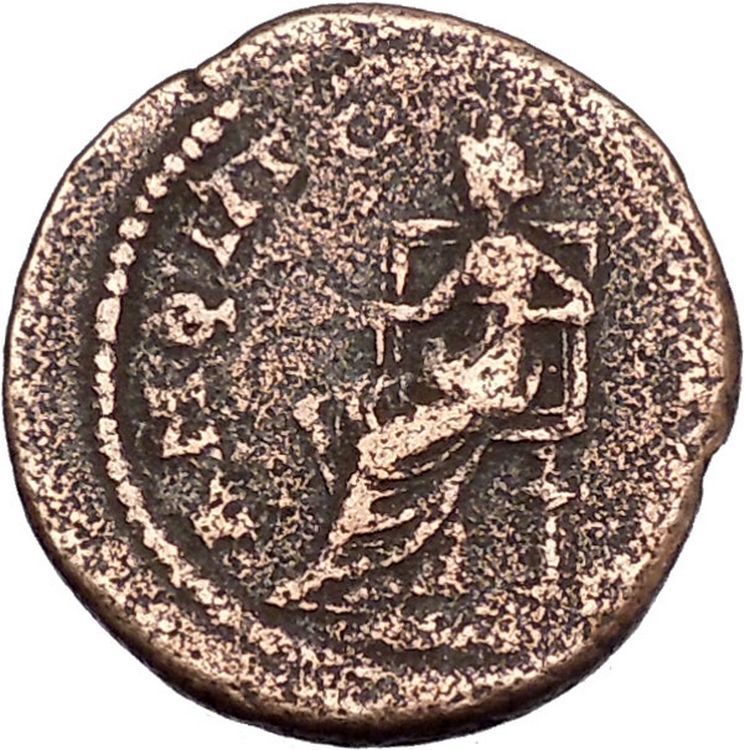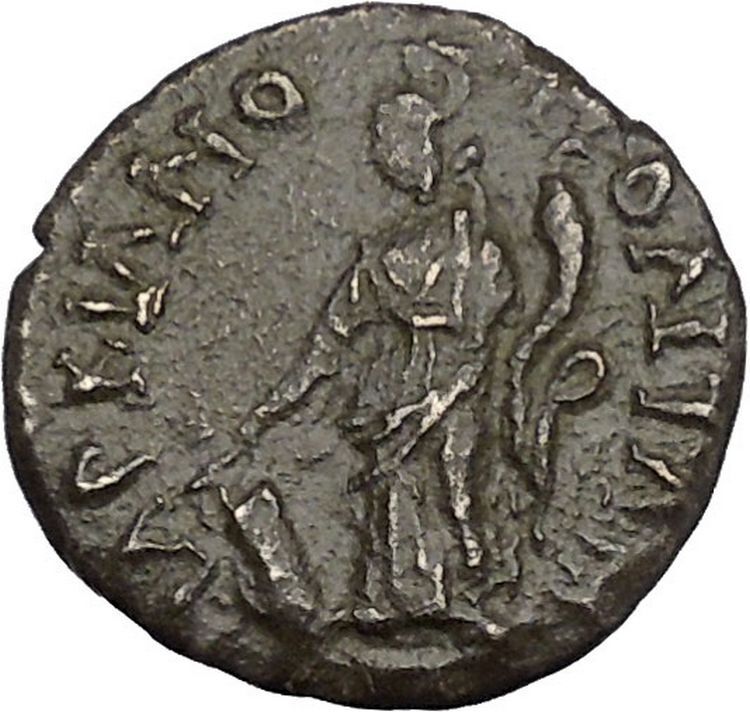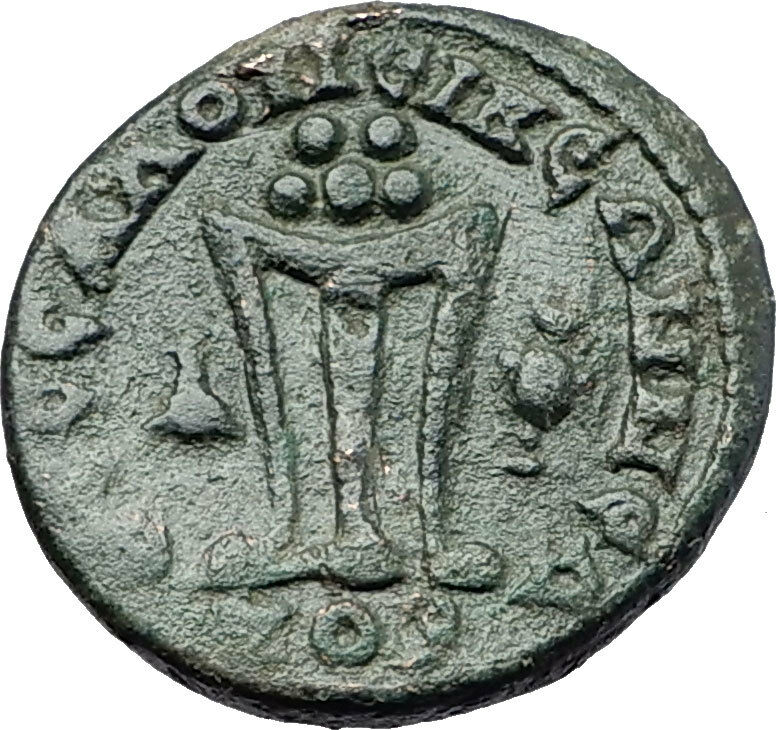|
Septimius Severus
–
Roman Emperor
: 193-211 A.D. –
Bronze 15mm (2.45 grams) of
Nicopolis ad Istrum in Moesia Inferior in Moesia Inferior 193-211 A.D.
Laureate head right.
Turreted, draped bust of
Serapis right.
You are bidding on the exact item pictured,
provided with a Certificate of Authenticity and Lifetime Guarantee of
Authenticity.

Serapis
(Latin spelling, or Sarapis in Greek) was a
syncretic
Hellenistic
–Egyptian
god in
Antiquity
. His most renowned temple was the
Serapeum of Alexandria
. Under
Ptolemy Soter
, efforts were made to integrate
Egyptian religion with that of their Hellenic rulers. Ptolemy’s policy was to
find a deity that should win the reverence alike of both groups, despite the
curses of the Egyptian priests against the gods of the previous foreign rulers (i.e
Set
who was lauded by the
Hyksos
).
Alexander the Great
had attempted to use
Amun for this purpose, but he was more prominent in
Upper

Egypt,
and not as popular with those in
Lower Egypt
, where the Greeks had stronger
influence. The Greeks had little respect for animal-headed figures, and so a
Greek-style
anthromorphic
statue was chosen as the
idol
, and proclaimed as the equivalent of the
highly popular
Apis
. It was named Aser-hapi (i.e.
Osiris-Apis), which became Serapis, and was said to be
Osiris
in full, rather than just his
Ka
(life force).
History
The earliest mention of a Serapis is in the disputed death scene of
Alexander (323 BC). Here, Serapis has a temple at
Babylon
, and is of such importance that he
alone is named as being consulted on behalf of the dying king. His presence in
Babylon would radically alter perceptions of the mythologies of this era, though
fortunately it has been discovered that the unconnected Babylonian god Ea (Enki)
was titled Serapsi, meaning king of the deep, and it is possibly
this Serapsi which is referred to in the diaries. The significance of this
Serapsi in the Hellenic psyche, due to its involvement in Alexander’s death,
may have also contributed to the choice of Osiris-Apis as the chief
Ptolemaic god.
According to Plutarch
, Ptolemy stole the
cult statue
from
Sinope
, having been instructed in a dream by
the
unknown god
, to bring the statue to
Alexandria
, where the statue was pronounced to
be Serapis by two religious experts. One of the experts was of the
Eumolpidae
, the ancient family from whose
members the hierophant
of the
Eleusinian Mysteries
had been chosen since
before history, and the other was the scholarly Egyptian priest
Manetho
, which gave weight to the judgement
both for the Egyptians
and the Greeks.
Plutarch may not however be correct, as some Egyptologists allege that the
Sinope in the tale is really the hill of Sinopeion, a name given to the site
of the already existing
Serapeum
at
Memphis
. Also, according to
Tacitus
, Serapis (i.e. Apis explicitly
identified as Osiris in full) had been the god of the village of
Rhakotis
, before it suddenly expanded into the
great capital of Alexandria.
The statue suitably depicted a figure resembling
Hades
or
Pluto
, both being kings of the Greek
underworld
, and was shown enthroned with the
modius
, a basket/grain-measure, on his
head, since it was a Greek
symbol
for the land of the dead. He also held a
sceptre
in his hand indicating his rulership,
with Cerberus
, gatekeeper of the underworld, resting
at his feet, and it also had what appeared to be a
serpent
at its base, fitting the Egyptian
symbol of rulership, the
uraeus
.
With his (i.e. Osiris’) wife
Isis, and their son (at this point in history)
Horus
(in the form of
Harpocrates
), Serapis won an important place in
the Greek world, reaching
Ancient Rome
, with
Anubis
being identified as Cerberus. In Rome,
Serapis was worshiped in the Iseum Campense, the sanctuary of the goddess
Isis located in the
Campus Martius
and built during the
Second Triumvirate
. The Roman cults of Isis and
Serapis gained in popularity late in the first century thanks to the god’s role
in the miracles that the imperial usurper
Vespasian
experienced in the city of
Alexandria
, where he stayed prior to his return
to Rome as emperor in
70 AD
. From the
Flavian Dynasty
on, Serapis sometimes appeared
on imperial coinage with the reigning emperor. The great cult survived until
385, when a Christian mob destroyed the
Serapeum
of Alexandria, and subsequently the
cult was forbidden by the
Theodosian decree
.
The early Alexandrian Christian community appears to have been rather
syncretic in their worship of Serapis and Jesus and would prostrate themselves
without distinction between the two. A letter inserted in the
Augustan History
, ascribed to the Emperor
Hadrian
, refers to the worship of Serapis by
residents of Egypt who described themselves as
Christians
, and Christian worship by those
claiming to worship Serapis, suggesting a great confusion of the cults and
practices:
The land of Egypt, the praises of which you have been recounting to me,
my dear Servianus, I have found to be wholly light-minded, unstable, and
blown about by every breath of rumour. There those who worship Serapis are,
in fact, Christians, and those who call themselves bishops of Christ are, in
fact, devotees of Serapis. There is no chief of the Jewish
synagogue
, no
Samaritan
, no Christian
presbyter
, who is not an
astrologer
, a
soothsayer
, or an anointer. Even the
Patriarch
himself, when he comes to Egypt,
is forced by some to worship Serapis, by others to worship Christ.
Nicopolis ad Istrum was a
Roman
and Early
Byzantine
town founded by Emperor
Trajan
around
101–106, at the junction of the Iatrus (Yantra)
and the Rositsa
rivers, in memory of his victory over the
Dacians
. Its
ruins are located at the village of
Nikyup
, 20 km north of
Veliko Tarnovo
in northern
Bulgaria
.
The town reached its apogee during the reigns of Trajan,
Hadrian
, the
Antonines
and the
Severan dynasty
.

The classical town was planned according to the orthogonal system. The
network of streets, the forum surrounded by an Ionic colonnade and many
buildings, a two-nave room later turned into a basilica and other public
buildings have been uncovered. The rich architectures and sculptures show a
similarity with those of the ancient towns in Asia Minor. Nicopolis ad Istrum
had issued coins, bearing images of its own public buildings.
In
447 AD
, the town was destroyed by
Attila’s
Huns
.
Perhaps it was already abandoned before the early 400s.
In the 6th century, it was rebuilt as a powerful fortress enclosing little more
than military buildings and churches, following a very common trend for the
cities of that century in the Danube area.The largest area of the extensive ruins (21.55 hectares) of the classical
Nicopolis was not reoccupied since the fort covered only one fourth of it (5.75
hectares), in the southeastern corner.
The town became an episcopal centre during the early Byzantine period. It was
finally destroyed by the Avar invasions at the end of the 6th century. A
Bulgarian medieval settlement arose upon its ruins later (10th-14th century).
Nicopolis ad Istrum can be said to have been the birthplace of
Germanic
literary tradition. In the 4th century, the
Gothic
bishop,
missionary and translator
Ulfilas
(Wulfila)
obtained permission from Emperor
Constantius II
to immigrate with his flock of converts to Moesia and settle
near Nicopolis ad Istrum in 347-8.
There, he invented the
Gothic alphabet
and translated the
Bible
from
Greek
to
Gothic
.
L ucius Septimius Severus (or rarely Severus I) (April 11, ucius Septimius Severus (or rarely Severus I) (April 11,
145/146-February 4, 211) was a
Roman
general, and
Roman
Emperor
from April 14, 193 to 211. He was born in what is now the
Berber
part of
Rome’s historic
Africa Province
.
Septimius Severus was born and raised at
Leptis
Magna
(modern Berber
, southeast of
Carthage
,
modern Tunisia
).
Severus came from a wealthy, distinguished family of
equestrian
rank. Severus was of
Italian
Roman ancestry on his mother’s side and of
Punic
or
Libyan
-Punic[1]
ancestry on his father’s. Little is known of his father,
Publius Septimius Geta
, who held no major political status but had two
cousins who served as consuls under emperor
Antoninus Pius
. His mother, Fulvia Pia’s family moved from
Italy
to
North
Africa
and was of the
Fulvius
gens,
an ancient and politically influential clan, which was originally of
plebeian
status. His siblings were a younger
Publius Septimius Geta
and Septimia Octavilla. Severus’s maternal cousin was
Praetorian Guard
and consul
Gaius Fulvius Plautianus
.[2]
In 172, Severus was made a
Senator
by the then emperor
Marcus Aurelius
. In 187 he married secondly
Julia
Domna
. In 190 Severus became
consul
, and in
the following year received from the emperor
Commodus
(successor to Marcus Aurelius) the command of the
legions
in Pannonia
.
On the murder of
Pertinax
by
the troops in 193, they proclaimed Severus Emperor at
Carnuntum
,
whereupon he hurried to Italy. The former emperor,
Didius Julianus
, was condemned to death by the Senate and killed, and
Severus took possession of Rome without opposition.
The legions of
Syria
, however, had proclaimed
Pescennius Niger
emperor. At the same time, Severus felt it was reasonable
to offer
Clodius Albinus
, the powerful governor of Britannia who had probably
supported Didius against him, the rank of Caesar, which implied some claim to
succession. With his rearguard safe, he moved to the East and crushed Niger’s
forces at the
Battle of Issus
. The following year was devoted to suppressing Mesopotamia
and other Parthian vassals who had backed Niger. When afterwards Severus
declared openly his son
Caracalla
as successor, Albinus was hailed emperor by his troops and moved to Gallia.
Severus, after a short stay in Rome, moved northwards to meet him. On
February
19
, 197
,
in the
Battle of Lugdunum
, with an army of 100,000 men, mostly composed of
Illyrian
,
Moesian
and
Dacian
legions,
Severus defeated and killed Clodius Albinus, securing his full control over the
Empire.
Emperor
Severus was at heart a
soldier
, and
sought glory through military exploits. In 197 he waged a brief and successful
war against the
Parthian Empire
in retaliation for the support given to Pescennius Niger.
The Parthian capital
Ctesiphon
was sacked by the legions, and the northern half of
Mesopotamia
was restored to Rome.
His relations with the
Roman
Senate
were never good. He was unpopular with them from the outset, having
seized power with the help of the military, and he returned the sentiment.
Severus ordered the execution of dozens of Senators on charges of corruption and
conspiracy
against him, replacing them with his own favorites.
He also disbanded the
Praetorian Guard
and replaced it with one of his own, made up of 50,000
loyal soldiers mainly camped at
Albanum
, near Rome (also probably to grant the emperor a kind of centralized
reserve). During his reign the number of legions was also increased from 25/30
to 33. He also increased the number of auxiliary corps (numerii), many of
these troops coming from the Eastern borders. Additionally the annual wage for a
soldier was raised from 300 to 500
denarii
.
Although his actions turned Rome into a military
dictatorship
, he was popular with the citizens of Rome, having stamped out
the rampant corruption of Commodus’s reign. When he returned from his victory
over the Parthians, he erected the
Arch of Septimius Severus
in Rome.
According to Cassius Dio,[3]
however, after 197 Severus fell heavily under the influence of his Praetorian
Prefect,
Gaius Fulvius Plautianus
, who came to have almost total control of most
branches of the imperial administration. Plautianus’s daughter,
Fulvia Plautilla
, was married to Severus’s son, Caracalla. Plautianus’s
excessive power came to an end in 205, when he was denounced by the Emperor’s
dying brother and killed.[4]
The two following praefecti, including the jurist
Aemilius Papinianus
, received however even larger powers.
Campaigns in Caledonia (Scotland)
Starting from 208 Severus undertook a number of military actions in
Roman
Britain
, reconstructing
Hadrian’s Wall
and campaigning in
Scotland
.
He reached the area of the
Moray
Firth
in his last campaign in Caledonia, as was called Scotland by the
Romans.[5].
In 210 obtained a peace with the
Picts
that lasted
practically until the final withdrawal of the Roman legions from Britain
[6]
,
before falling severely ill in
Eboracum
(York).
Death
He is famously said to have given the advice to his sons: “Be harmonious,
enrich the soldiers, and scorn all other men” before he died at Eboracum on
February 4
,
211[7].
Upon his death in 211, Severus was
deified
by the Senate and succeeded by his sons,
Caracalla
and
Geta
, who were advised by his wife
Julia
Domna
.[8]
The stability Severus provided the Empire was soon gone under their reign.
Accomplishments and Record
Though his military expenditure was costly to the empire, Severus was the
strong, able ruler that Rome needed at the time. He began a tradition of
effective emperors elevated solely by the military. His policy of an expanded
and better-rewarded army was criticized by his contemporary
Dio Cassius
and
Herodianus
: in particular, they pointed out the increasing burden (in the
form of taxes and services) the civilian population had to bear to maintain the
new army.
Severus was also distinguished for his buildings. Apart from the triumphal
arch in the Roman Forum carrying his full name, he also built the
Septizodium
in Rome and enriched greatly his native city of
Leptis
Magna
(including another triumphal arch on the occasion of his visit of
203).
Severus and Christianity
Christians were
persecuted
during the reign of Septimus Severus. Severus allowed the
enforcement of policies already long-established, which meant that Roman
authorities did not intentionally seek out Christians, but when people were
accused of being Christians they could either curse
Jesus
and make an
offering to
Roman gods
, or be executed. Furthermore, wishing to strengthen the peace by
encouraging religious harmony through
syncretism
,
Severus tried to limit the spread of the two quarrelsome groups who refused to
yield to syncretism by outlawing
conversion
to Christianity or
Judaism
.
Individual officials availed themselves of the laws to proceed with rigor
against the Christians. Naturally the emperor, with his strict conception of
law, did not hinder such partial persecution, which took place in
Egypt
and the
Thebaid
, as
well as in
Africa proconsularis
and the East. Christian
martyrs
were
numerous in Alexandria
(cf.
Clement of Alexandria
, Stromata, ii. 20;
Eusebius
, Church History, V., xxvi., VI., i.). No less severe were
the persecutions in Africa, which seem to have begun in 197 or 198 (cf.
Tertullian’s
Ad martyres), and included the Christians known in the
Roman martyrology
as the martyrs of
Madaura
.
Probably in 202 or 203
Felicitas
and
Perpetua
suffered for their faith. Persecution again raged for a short time
under the proconsul
Scapula
in
211, especially in
Numidia
and
Mauritania
.
Later accounts of a Gallic
persecution, especially at
Lyon, are
legendary. In general it may thus be said that the position of the Christians
under Septimius Severus was the same as under the
Antonines
;
but the law of this Emperor at least shows clearly that the
rescript
of
Trajan
[
neededclarification] had failed to execute its purpose..
|








 ucius Septimius Severus (or rarely Severus I) (April 11,
ucius Septimius Severus (or rarely Severus I) (April 11, 


